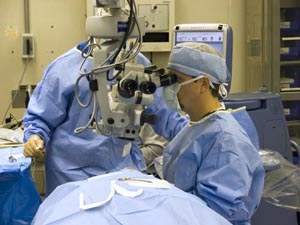Donor corneas that are not suitable for cornea transplants may be a better option for patients needing tissue to cover a glaucoma shunt than the traditional tissue used in such operations, according to new research from the University of Alabama at Birmingham. The findings, published in the Journal of Glaucoma, suggest that cornea tissue is more durable and potentially safer than the more commonly used pericardium grafts.

Glaucoma patients often have a drainage device called a shunt surgically implanted to reduce intraocular pressure in the eye. The shunt tubes are typically covered by a patch graft to ensure the tube does not erode, which could lead to severe infections.
A commonly used material for the graft is pericardium, tissue from the sac that surrounds the heart and is routinely obtained from deceased human donors by tissue banks. The UAB team studied cornea tissue obtained from eye banks. In patients undergoing tube implantation for the first time, the cornea grafts were less likely to thin or erode over time than grafts from pericardium, leaving patients at lower risk for infection or subsequent reparative surgery.
“This is the first study to directly compare glycerol-preserved corneal tissue to another patch graft material in glaucoma shunt surgery,” says Christopher A. Girkin, M.D., chair of the UAB Department of Ophthalmology and senior author of the study. “It demonstrates that corneal tissue is more effective than pericardium in preventing tube erosion and may also delay the time to erosion. Additionally, it provides a superior cosmetic result than other available materials.”
|
The UAB Department of Ophthalmology has worked with the Alabama Eye Bank for the past three years to develop and improved the use of glycerol-preserved corneas in glaucoma surgery to enhance the care of advanced glaucoma patients. |
The corneas were preserved in glycerol, which confers long shelf life at room temperature, by Global Sight Network, based in Birmingham, a service of the Alabama Eye Bank. GSN is a non-profit consortium of 33 U.S. eye banks that preserves in glycerol medically eligible corneas not meeting criteria for optical keratoplasty for distribution to qualified facilities worldwide. The UAB Department of Ophthalmology has worked with the Alabama Eye Bank for the past three years to develop and improved the use of glycerol-preserved corneas in glaucoma surgery to enhance the care of advanced glaucoma patients.
“We’re delighted about the study results, and we are excited about the impact GSN’s corneas will have on the many people suffering from glaucoma,” says Doyce Williams, GSN president and CEO.
“Some of the corneas donated to eye banks for transplant into patients with cornea disease are not optically clear enough and thus are unsuited for that task,” says Christine Curcio, Ph.D., professor of ophthalmology at UAB and director of the Global Sight Network. “However, this research indicates that they are suited for use as patch grafts for glaucoma patients, providing for very efficient utilization of this valuable tissue resource.”
Glaucoma is a complex disease in which damage to the optic nerve leads to progressive, irreversible vision loss. Glaucoma is the second-leading cause of blindness in the world. While increased pressure inside the eye — called intraocular pressure, or IOP — is usually present in the disease, even patients with normal range IOP can develop glaucoma.
The study was done with the assistance of the physicians of the UAB Glaucoma Service at the Callahan Eye Hospital: Girkin, Jason C. Swanner, M.D., and D. Wade Joiner, M.D., along with ophthalmology Fellow Eric Wigton, M.D. The UAB Glaucoma Service is the only group subspecialty practice in Alabama that focuses exclusively on treating patients with glaucoma and is actively involved in clinical and laboratory research to develop new treatments and management options for glaucoma patients. Joiner and Andrew Mays, M.D., became full-time members in the Department of Ophthalmology on Oct. 1.